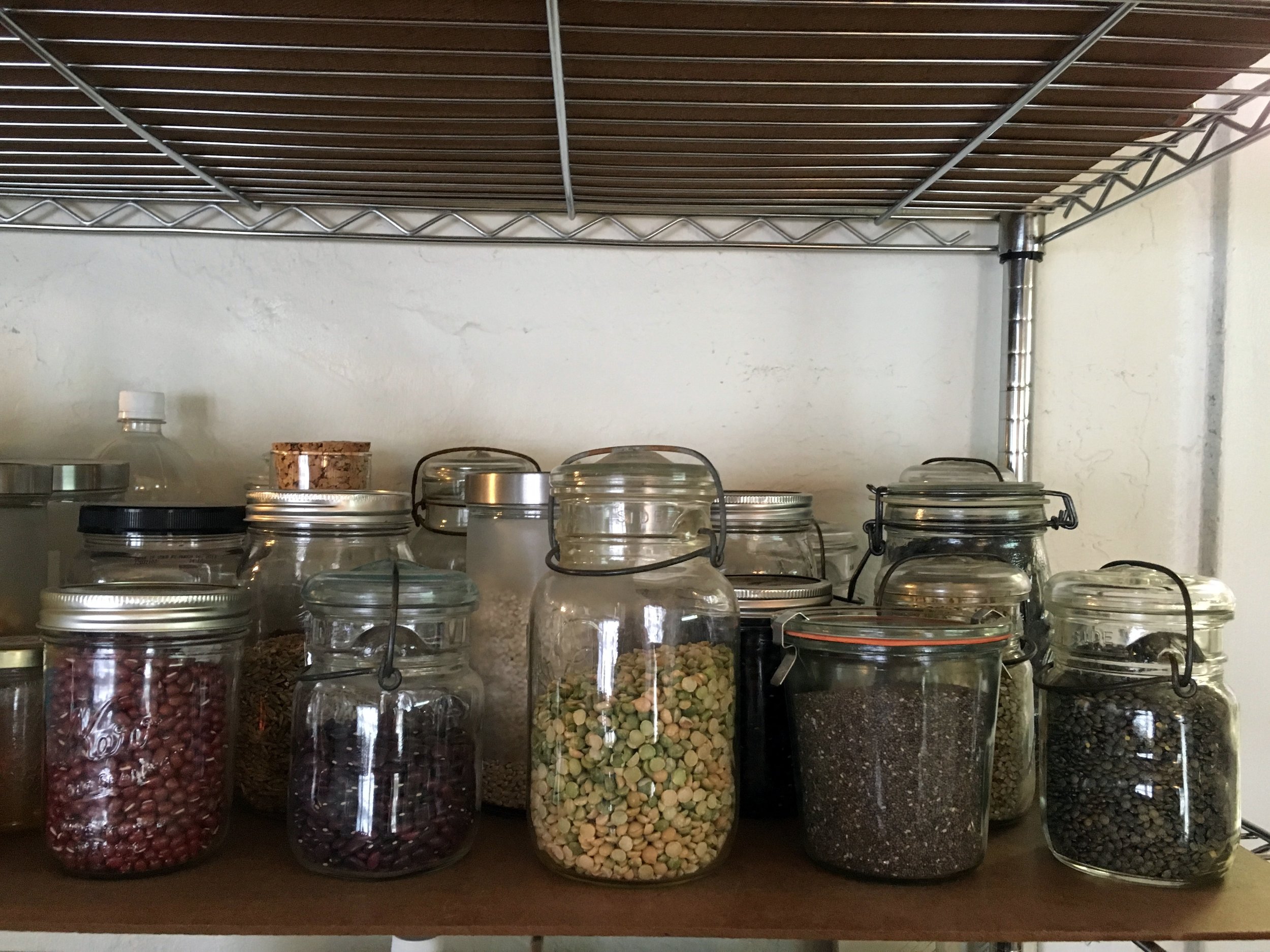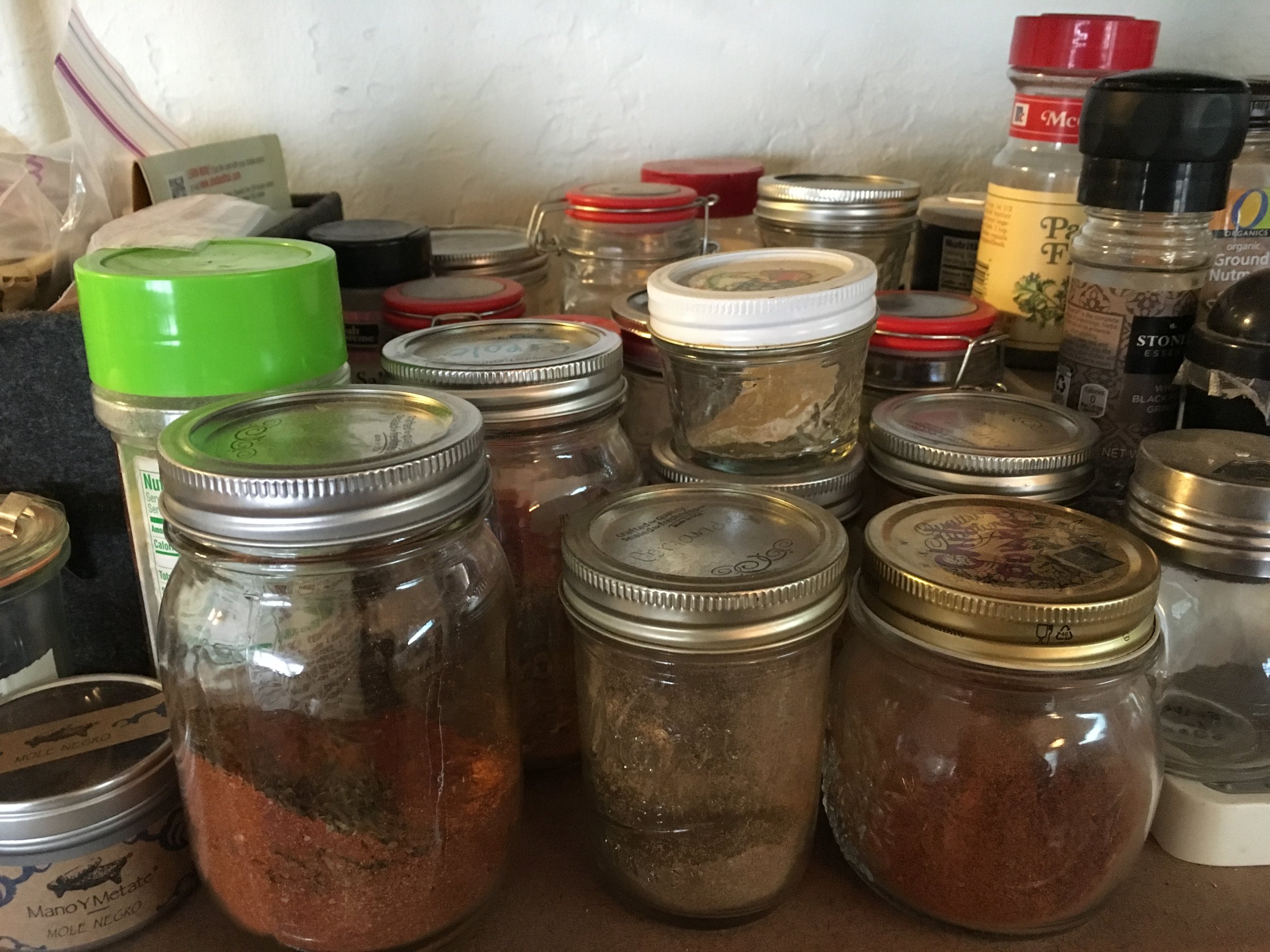A Pinch of Spice and Everything Nice: How to Stock Your Kitchen
This post was written by Local Foods Intern, Azalea Thomson.
Stocking a Healthy Kitchen
It’s a well-known phrase, and we’ve all probably heard it many times: "Eat your fruits and vegetables!" Perhaps it is accompanied by a finger wag, a disapproving glance at the untouched vegetables on your plate, or possibly the most annoying—a toothy grin from someone with that glowing aura of health.
Though these individuals may truly have the best intentions, in reality, learning to eat better stems from a kitchen stocked with important ingredients and the knowledge of how to prepare these ingredients to create something delicious. Of course fruits and vegetables are important, but without the right tools and flavors to serve up a healthy, homemade meal, often times those all-important foods stay huddled in their dark crisper drawer, only to turn into a funky-smelling bag of "Anybody know what this is?"
Below are some of the basics for developing your own healthy kitchen, as well as a look inside the fridge and pantry of Local Foods Development Coordinator, Rachel Morningstar.
In laying the foundation for a healthy kitchen, it is best to start by considering the following questions:
Is it a whole food (not processed)? Is it locally grown? Is it seasonal? Is it organic?
From there, you can begin to build a diet based on sustainable and nutrient rich foods 90% of the time, while still leaving room for treats and indulgences in the remaining 10%. A few very important ingredients that help to enhance the flavor and enjoyment of healthy foods include oil, sugar, flour and grains, protein, and seasoning. A misconception that often leads to disaster is that all oils, all sugars, and all grains are bad. The truth is that when consumed in the right quantity and form, these foods provide a great option for creating a delicious and healthy meal.
Oil sold in grocery stores today is often found in a very different form than 100 years ago. Originally, oil was obtained using a non-mechanized, stone-pressing method, derived from olives, sesame seeds, and coconuts. Today, oil is often processed using high heat methods, which rapidly lower its nutritious properties. The healthiest oils are organic, unrefined, and cold-pressed. Try using olive oil in your next homemade salad dressing, adding sesame oil after stir-frying vegetables in water, and substituting coconut oil for butter in your next baking adventure.
Sugar is also an essential part of our diet, but not in the refined form that seems to hide in every packaged food item on the grocery shelves. Sugar is found naturally in fruit, honey, sugar cane, and maple syrup. Refined sugar on the other hand, is highly processed and causes a spike in blood glucose, leading to a sugar crash. Because whole foods are absorbed more slowly, the crash in energy can be avoided. Refined grains (or simple carbohydrates) act in the same way as refined sugar, causing spikes in blood glucose levels. This is why using sweeteners such as raw honey, maple syrup, agave syrup, and raw sugar are better alternatives, without sacrificing taste!
Did you know that in some parts of the world it is still common practice to go to the mill, pick out your preferred grain, and have it ground into flour? In the U.S., we are so far removed from this process that often times pounds of flour sit on dusty shelves for months before their use. Whole grains are much better for us because they still contain the protein and fiber of the seed’s endosperm. When grains are stripped of their endosperm they become refined, and they turn into simple carbohydrates so that your body reacts to a cup of white rice as if it were a cup of sugar. By eating whole grains like quinoa, oats, brown rice, farro, wheat and rye berries, and barley, you gain both energy and nutrients that help clean the inside of the body.
Another important component of a balanced meal is protein. Protein is found in many foods (not just meat!) and you may be surprised to learn just how much protein you can gain from foods like broccoli (4 g/ cup), quinoa (8 g/ cup), pinto beans (15 g/ cup), and lentils (18 g/ cup). One cup of chicken contains 43 grams of protein, however according to the Dietary Reference Intake, the average woman only needs 46 grams of protein per day, while the average man only needs 56 grams. Therefore, an entire meal of 1 cup of quinoa, 1 cup of broccoli, and 1 cup of lentils would give you 30 grams of protein all in one balanced meal containing grains, greens, and beans. Nuts and seeds are also a great source of protein so by throwing a small handful of nuts on top of salad you can easily add some protein to your meal.
Most people would benefit from reducing the amount of meat, poultry, and fish they consume because it impacts the environment so profoundly, however this does not mean everyone must immediately go vegetarian. By eating a variety of protein including soy products, beans, dairy, eggs, fish, fowl, and less frequently goat, sheep, and beef, you can greatly reduce your environmental impact. Plant-based proteins are also notoriously cheap, and buying in bulk and dry rather than canned lower the cost even more.
A well-stocked kitchen should include appeal to our innate tastes for bitter, salty, sour, sweet, and umami. Finding a balance of these flavors will ultimately bring a meal together and enhance both your enjoyment of the food, and your likelihood of continuing to eat a healthy diet. Citrus, contained in foods such as lemons, limes and oranges are excellent in salad dressings to balance acidity with oil. Vinegars such as apple cider, white wine, and balsamic each have unique flavors that contribute to a bright and bold taste. Umami is a flavor that some may be unfamiliar with and is contained in fermented condiments such as miso and soy sauce, mustard, and mushrooms. These flavors also satisfy salt cravings and work wonderfully well in sauces.
Finally, a balanced and delicious meal would not be complete without spices and herbs. Cayenne pepper, cinnamon, curry powder, garlic powder, and thyme are just a few spices that give a dish a strong flavor and build those powerful food memories. Herbs and roots such as rosemary, basil, cilantro, mint, and ginger add freshness and strong flavor to a dish as well. Keeping herb plants in pots on a windowsill, or even keeping them in a jar in the fridge ensure long-lasting flavors at a low cost.
Hopefully, this will give you an idea of where to start, and help you get excited about the endless combinations of delicious flavors that you can make with a kitchen of healthy ingredients.
Inside Rachel’s Kitchen
What foods do you always have in your fridge and pantry?
Spinach or kale, carrots, onions, garlic, brown rice, some kind of seasonal fruit, lemons, olive oil, fresh herbs, and spices.
If you were stranded on a desert island, what spices would you choose to keep?
Cumin, cayenne, cinnamon, oregano, coriander, and thyme.
What is your go-to meal in a pinch?
Eggs prepared in either a sandwich or a scramble, maybe a frittata,, usually with greens and salsa or whatever other veggies I happen to have in the fridge.
What do you do with leftovers?
I try to make things that I will like enough to eat a second time or only make small portions of things so I don't have leftovers. I don't really like leftovers.
What is one food you couldn't live without?
I'm not sure I could narrow it down to a specific food or dish, but I know that fruit is my favorite food group and that I could not live without fruit.
How often do you clean out the fridge?
I clean out the fridge every week after I go to the grocery store. I don't like to keep leftovers for longer than that.
Do you prepare foods in bulk? And if so, what foods?
I like to prepare big batches of lasagna and chili. Those are about the only foods that I like to eat as leftovers.
Which is your most important refrigerator shelf?
The top shelf is where I put the things I want to eat first and where all the leftovers go. The next most important would be my vegetable drawer.
Do you bake? If so, what are three of your baking staples?
I do bake, but not often. Usually I bake muffins, banana bread, or brownies. I always like to have Hayden Flour Mills flour on hand in addition to raw sugar and baking powder. I almost always have chocolate chips in the freezer as well.
What motivates you to cook?
Being hungry! I also like cooking for others, having friends over for dinner and sharing a meal together.






